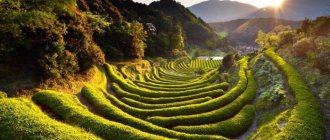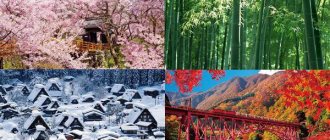Much of Japan consists of steep mountains, densely covered with forest. Its northern shores lie south of Russia's icy east, while its southern islands reach almost into the tropics, making Japan home to a wealth of wildlife. Japan's fauna includes about 130 species of land mammals and more than 600 species of birds.
photo
Land animals include bears, raccoon dogs, foxes, deer, hares and weasels; some species differ from the neighboring Asian continent. Wild monkeys are common in many places. At their northernmost point, the islands of Honshu represent the northern limit of the world's apes. The amazing animal world of Japan has preserved many endemic and even relict animals.
Reptiles are represented by marine and freshwater turtles, snakes and lizards. Most snakes, including the 1.5 meter island snake, are harmless and only two species of snakes are venomous. There are also many species of toads and newts. Endemic to the Japanese Islands, the Japanese giant salamander can reach a length of 1.2 meters or more. Insect life is typical for a moderately humid climate.
photo Japanese giant salamander
The Japanese archipelago is one of the main flyways for many birds in East Asia. Common waterfowl include gulls, loons, albatrosses, petrels, herons, ducks, geese, and swans. There are about 150 species of songbirds, as well as eagles, hawks, falcons, pheasants, partridges, quails, owls and woodpeckers.
photo Petrel
The confluence of cold and warm ocean currents near Japan contributed to a rich marine life. It is home to whales, dolphins, porpoises and many fish such as sardines, sea bream, mackerel, tuna, trout, herring, mullet, capelin and cod. Crustaceans and shellfish include crabs, shrimp, mussels, and oysters. The rivers and lakes abound with trout, salmon and crayfish.
Although the fauna of Japan, due to its island position, is poor compared to mainland Asia. The fauna contains species characteristic of tropical, subtropical, boreal and mountain forests. Here are some of the most interesting and unique ones:
Climate
Highlands, low and medium-high mountains occupy more than two-thirds of the entire territory of Nippon. There are lowlands in places along the coastline. Winds blow on the islands in winter from the mainland, and in summer from the ocean.
In each of the climatic zones live the corresponding species of animals, of which there are fewer than on the continent, and they are smaller compared to their continental counterparts.
At the same time, the isolation of the islands contributes to the habitat of relict and endemic species of flora and fauna.
Endemics (the name comes from the Greek word for “local”) are plants or animals that are distributed only in a certain area and are not found outside of it.
Fauna of Japan: unique animals of Japanese fauna
Japan is famous for its rich nature. The wide variety of landscapes determines the presence of unique flora and fauna in the country. There are more than 80 thousand species of animals in Japan. Many of them are among the country's endemic fauna. Below are the most famous animals of Japan with photos and descriptions.
Japanese or Ussuri crane
The Japanese consider this beautiful bird a symbol of good luck and longevity. The Japanese crane is one of the rarest representatives of the crane family.
A characteristic feature of the appearance of these birds is the presence of a red spot on the top of the head. During the mating season, it takes on a particularly bright red hue.
In general, the plumage of the Japanese crane is snow-white, but the feathers on the lower part of the wings are black. Males also have a black throat and neck.
Red-crowned cranes are found in Hokkaido. As a rule, they do not migrate. Red-crowned cranes are omnivores. The basis of their diet is rice, carrots and aquatic plants.
Ussuri white-breasted bear
This animal of Japan represents the largest subspecies of the Himalayan bear. The Ussuri white-breasted bear is found in the Far East, including the Korean Peninsula. Its specific name is associated with the Ussuri River, which flows on the border between Russia and China.
This type of bear has a characteristic white or cream-colored “moon” collar, like the Himalayan bear. The main difference is the larger ears. The weight of males reaches about 200 kg, and that of females – up to 140 kg.
These animals spend most of the winter hibernating, and at other times of the year they are predominantly nocturnal. The Ussuri white-breasted bear is omnivorous. The basis of its diet consists of nuts, grass and termites.
Sea lion
This animal is the largest representative of eared seals, but is inferior in size to pinnipeds. Steller sea lions are lighter in color than most sea lions. Their color varies from pale yellowish to reddish-red.
Males differ from females by having higher foreheads and coarse hair on the neck. Sea lions live in the coastal waters of Hokkaido. These are predominantly carnivores, which themselves can become prey for killer whales.
Japanese water turtle
This species of turtle represents the endemic species of the Japanese fauna. Over the past two decades, the population of these reptiles has decreased significantly. But the species is not yet considered a rare animal in Japan.
The Japanese water turtle has a yellowish-brown shell and an olive-brown head. Females are larger than males. Their body length can reach 21 cm. But males have longer tails. Japanese river turtles feed on frogs, insects, tadpoles and earthworms.
Green pheasant
This beautiful bird is endemic to the fauna of the Japanese archipelago. The green pheasant is also considered the national bird of Japan. It is found mainly in Honshu, Kyushu and Shikoku. In these regions, green pheasants are found everywhere, including in fields, farms and in the homes of local residents.
Males have green plumage on the chest and sides. Females are distinguished by brown-black plumage and are slightly smaller in size than males.
In Japan, hunting green pheasants is allowed, but no more than two males of these birds can be caught per day. Shooting female green pheasants is prohibited.
Japanese giant salamander
This animal is endemic to Japan. The Japanese giant salamander is found in the southwest of the country. Body length in adults can reach 1.5 m, and weight – 25 kg. It is the second largest amphibian on the planet and one of the largest salamanders in the world.
The body of the Japanese giant salamander is colored in brown and black shades, which allows it to perfectly camouflage itself at the bottom of reservoirs. Her eyes are small, without eyelids, and her mouth is extended across the entire width of her head.
To protect themselves from predators, these Japanese animals release an unpleasant-smelling milky substance. Their diet mainly consists of insects, fish and frogs.
Dappled deer
This species of deer is found in some regions of East Asia. The vastness of Japan is home to a fairly large population of these animals. The body length of these deer reaches 1.6-1.8 m, and the weight is 75-130 kg.
In summer, the body color of sika deer is reddish-red with light spots, while in winter it is duller. This feature of appearance allows these animals to easily camouflage themselves in forest clearings. Sika deer feed mainly on herbaceous vegetation, fallen acorns and nuts, and in winter on tree bark.
Japanese macaque
This species of terrestrial macaque is sometimes also called "snow monkey". This is due to the fact that Japanese macaques live in areas where there is snow for several months of the year.
Males can weigh up to 11 kg, and females up to 8 kg. These monkeys are characterized by a pinkish complexion, while the body is covered with gray fur.
Japanese macaques have adapted to cold climates and are not afraid of low temperatures. These animals are omnivores. Their diet includes 213 species of plants and insects.
Dugong
This marine mammal is the only existing member of the dugong family. It is also a single marine mammal that feeds exclusively on plant foods. Dugongs are also sometimes called “sea cows” because their diet consists of algae.
The dugong is characterized by a massive cylindrical body, tapered at the edges. His skin is smooth and pale at birth, and becomes darker as he grows older. The dugong's tail resembles a dolphin's. These marine animals are found in warm coastal waters.
Climbing or Japanese tree hare
This animal from the hare family is endemic to the Japanese fauna. It is found on the islands of Amami-Oshima and Tokunoshima. This is a representative of the ancient hares that once lived in Asia.
The climbing hare has short legs and a massive body covered with thick dark brown hair. The claws on the front paws are straight, while those on the hind paws are curved. The diet of these animals in Japan is based on various plants, including shrubs and grass.
Serau
Meeting a serow couple is rare.
The animal is solitary by nature. For a long time, this animal is on the verge of extinction, so the serow was included in the Red Book long ago and is considered an endangered species. After this animal was declared a natural heritage in 1955, the serow population began to increase significantly.
But with this increase in the number of animals comes a lot of problems that people in different places are trying to solve in different ways. It was allowed to hunt serow until a certain number of them were shot in order not to bring these wolves in sheep's clothing to the brink of extinction again.
This animal is small in size, weighing about 38 kg with a height of up to 90 cm. There are also giants among them, whose weight reaches up to 130 kg. Male serows are usually larger than females. Both have horns, the rings of which determine the age of the animals. The serow's first ring appears at 1.5 years.
These wolves in sheep's clothing prefer to spend most of their lives in splendid isolation. They form a pair only during the rut in order to continue their race. They are active in the morning and evening.
Nature protection zones
The Japanese are very careful about their land and representatives of the animal world. Currently, there are thirty-four national parks in Nippon, twenty-eight of which were founded in the last century, the rest - later. They densely dotted the entire country. Most of them are in the following regions:
Seto-Nikai
Seto-Nikai National Park belongs to three regions: Kyushu, Kinki, Chugoku and Shikoku. It is geographically limited by the islands of Shikoku and Honshu. This is the first conservation park established in Japan (March 1934) to protect the inhabitants of the Inland Sea of Japan and the numerous islands, islets and rocks that belong to this reserve.
The Inland Sea is home to a wide variety of life forms. It is inhabited by rare fauna typical of tidal flats, seaweed beds, rocky shores and swampy shoals periodically flooded by the tide.
Let's take a look at some of the interesting animals found here.
Finless porpoise
In particular, here you can find the finless porpoise, which is found in the shallow, warm seas of mid-latitudes. It belongs to the mammals of the cetacean order that stay close to the coast. The length of its body reaches a little more than one and a half meters.
Birds
Let's start again with Hokkaido. As on other islands, there are a lot of birds here. The most interesting are the Japanese crane, thrush, starling, woodpecker, swallow, owl, eagle, black grouse, and hawk. On other islands there are quails, pheasants, and partridges.
Migratory birds are found everywhere in Japan. These are ducks, gulls, loons, geese, herons, swans, petrels, albatrosses.
There are also such interesting species of birds as the Japanese white-eye, oriental broadmouth, gray grubeater, Indian pitta, copper pheasant, mandarin duck, and shelduck.
Aquatic life
There are many fish in Japanese reservoirs. Living in fresh water, carp, catfish, eel, the last of them are very often used in the preparation of traditional dishes, in Japan there is a day when they eat eel meat, and on this day the store shelves are filled with dishes from this fish, this “holiday” takes place " in summer.
Among marine fish, tuna, herring, cod and flounder are also caught in large quantities. Representatives of the Sea of Japan such as shrimp, crabs, all kinds of shells, mussels and oysters are also very popular in national cuisine. The sea is rich in other inhabitants; dolphins, whales, different types of fish and even guinea pigs live in it.











